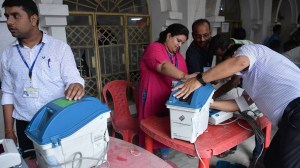- India
- International
From UP to Maharashtra, farmers say problem not in the field but in market
Farmers generally keep the crop harvested in March-April in these on-field raised platform structures (to prevent moisture ingress that cause the bulbs to sprout) and sell in tranches till September-October.
 Harvesting in progress in Chandauli, UP. (Express photo)
Harvesting in progress in Chandauli, UP. (Express photo)
In early November, the district administration of Chandauli in eastern Uttar Pradesh banned harvester combines, citing a state government order to prevent burning of parali (leftover straw) from the paddy cut by these machines. Panic-stricken farmers approached the district magistrate, who relented after obtaining an assurance that they would not burn any standing stubble after machine-harvesting. The permission came late: Paddy harvesting could start only by early-December, against the normal time from mid-November. And with heavy rains in December 11-13, the crop also suffered extensive damage and grain discolouration. COVID-19 LIVE updates
Now in April, as Chandauli’s farmers harvest wheat amid the lockdown, parali and air pollution is hardly an administrative priority. “Harvesting won’t be a problem. My district alone has over 100 combines, with an equal number coming from outside. We have some 230,000 acres under wheat, nearly three-fourths of which is combine-harvested and the rest manually using sickles. Each machine can do 35-40 acres over 18 hours daily,” says Ajay Kumar Singh. The 42-year-old farmer from Emiliya village in Chandauli district and tehsil has planted wheat on 40 acres and summer moong (green gram) on 12 acres, which will be harvested from May.
Don’t miss from Expained: 3 hotspots, 3 control models
Singh’s worry isn’t over harvesting. The authorities have issued passes for the combines and their operators – typically one foreman, two drivers and two helpers. “The grain will get cut, but we don’t know how it would be marketed. Wheat procurement is usually from around April 10. This time, it may not be before May,” he points out.
Echoing the same concern is Rao Gulab Singh Lodhi from Nanhegaon village in Gotegaon tehsil of Madhya Pradesh’s Narsinghpur district. He began harvesting his 36 acres of wheat in Wednesday, after having finished with chana (chickpea) and masur (red lentil) on 8 acres each in early March.
Read | In Dharavi: 8.5 lakh people holed up in 2.4 sq km

“My chana and masur is harvested, cleaned and graded for quality. But I cannot sell, as the APMC (agricultural produce market committee) mandi at Karakbel is closed and there’s nobody to buy,” notes Lodhi. While procurement in MP is slated to start from April 15 – a delay of over 15 days – he isn’t sure if that would help.
“The government has declared that it will not purchase more than 13 quintals per acre of wheat from any farmer, with these at 5 quintals each for chana and masur. My own average per-acre yield is 20 quintals in wheat, 12 quintals in masur and 10 quintals in chana. What do I do with the remaining crop, for which there are no takers today? They wants us to increase productivity, but are unwilling to procure our extra grain,” adds Lodhi.
Read | Slight but ‘noticeable’ flattening of growth curve in India
The story isn’t different in onions, where around 30 labourers are required to harvest one acre in a single day. For Santosh Gorade, a farmer from Takli Vinchur village in Niphad taluka of Maharashtra’s Nashik district, that isn’t an issue: “There are enough labourers in my village. Although the ones in nearby villages may not be able to come due to the lockdown, I can stagger my harvesting”.
Gorade plans to harvest his rabi onion on two out of his total 6-acre holding after April 20. Eknath Sanap, from Naigaon village in Nashik’s Sinnar taluka, harvested 200 quintals from 1.5 out of his 3 acres last week. He did not find it difficult to get labour, which is largely local.
Don’t miss from Explained: How a dollar swap line with US Fed can help in uncertain times
For both farmers, the primary concern is marketing. Rabi onions are amenable to storage in ‘kanda chawls’. Farmers generally keep the crop harvested in March-April in these on-field raised platform structures (to prevent moisture ingress that cause the bulbs to sprout) and sell in tranches till September-October. “Yes, I can take it to the market later. But what if after lockdown, everybody rushes to sell and the prices crash?,” asks Sanap.
Currently, the APMC mandis of Lasalgaon and Pimpalgaon in Nashik are functioning with skeletal staff. Unlike in farms, the labourers at these two big wholesale onion markets – those who unload, clean, bag and reload produce – are mostly from UP and Bihar, who have gone back due to the lockdown.
Read | Provide counselling to migrants: Centre to states
Availability of labour for farm work doesn’t seem a constraint even in sugarcane. According to Jitender Singh Hooda, an 8-acre farmer from Kheri Bairagi village of western UP’s Shamli district and tehsil, a skilled labourer can harvest, bundle and load 12-14 quintals of cane daily, for which he charges Rs 45/quintal. Four of them can, thus, deliver a full tractor trolley-load of 55-56 quintals for just over Rs 2,500.
The same job – of only harvesting and bundling 12-14 quintals – can also be done by three unskilled labourers. At a daily wage rate of Rs 350, it works out to Rs 4,200 for 56 quintals, plus another Rs 800 for loading on to the farmer’s trolley. “There’s no dearth of labour now, especially the people who have lost their jobs after lockdown. But they have little experience in cane cultivation,” explains Hooda.
Read | Three weeks and counting: Stranded and hungry at shut gateway
Hooda’s present workforce includes Rakesh, a ladies tailor; Vinod, an electrician; Manoj, a construction labourer; and Krishan Pal, a mender of old jute bags – all previously working in Shamli, Karnal and nearby towns. Technically more “skilled” than farm hands, they are now being engaged for sugarcane planting as well. Hooda estimates the cost of planting one acre using skilled workers at Rs 4,200. The same with the new less productive persons comes to Rs 6,000 or so, “but at least my work gets done”.
That harvesting labour isn’t a major issue is also borne out by sugar mills in UP crushing 932.08 lakh tonnes (lt) of cane during the current 2019-20 season till Friday. Over 100 lt out of this has been after the lockdown from March 25. “Nearly 85% of the season’s projected crushing of 1,100 lt is over. Mills will continue to crush beyond May-end,” UP’s cane commissioner Sanjay Bhoosreddy told The Indian Express.
Read | In March, people hoarded cash, withdrew four times more than monthly average
For cane growers, the main problem again is in getting money. They have so far supplied cane worth more than Rs 29,800 crore at the UP government’s advised price, but received only Rs 15,581 crore. Mills are unable to pay, as there is little offtake of sugar by industrial buyers or of ethanol by oil companies for blending with petrol.
Apr 18: Latest News
- 01
- 02
- 03
- 04
- 05






































